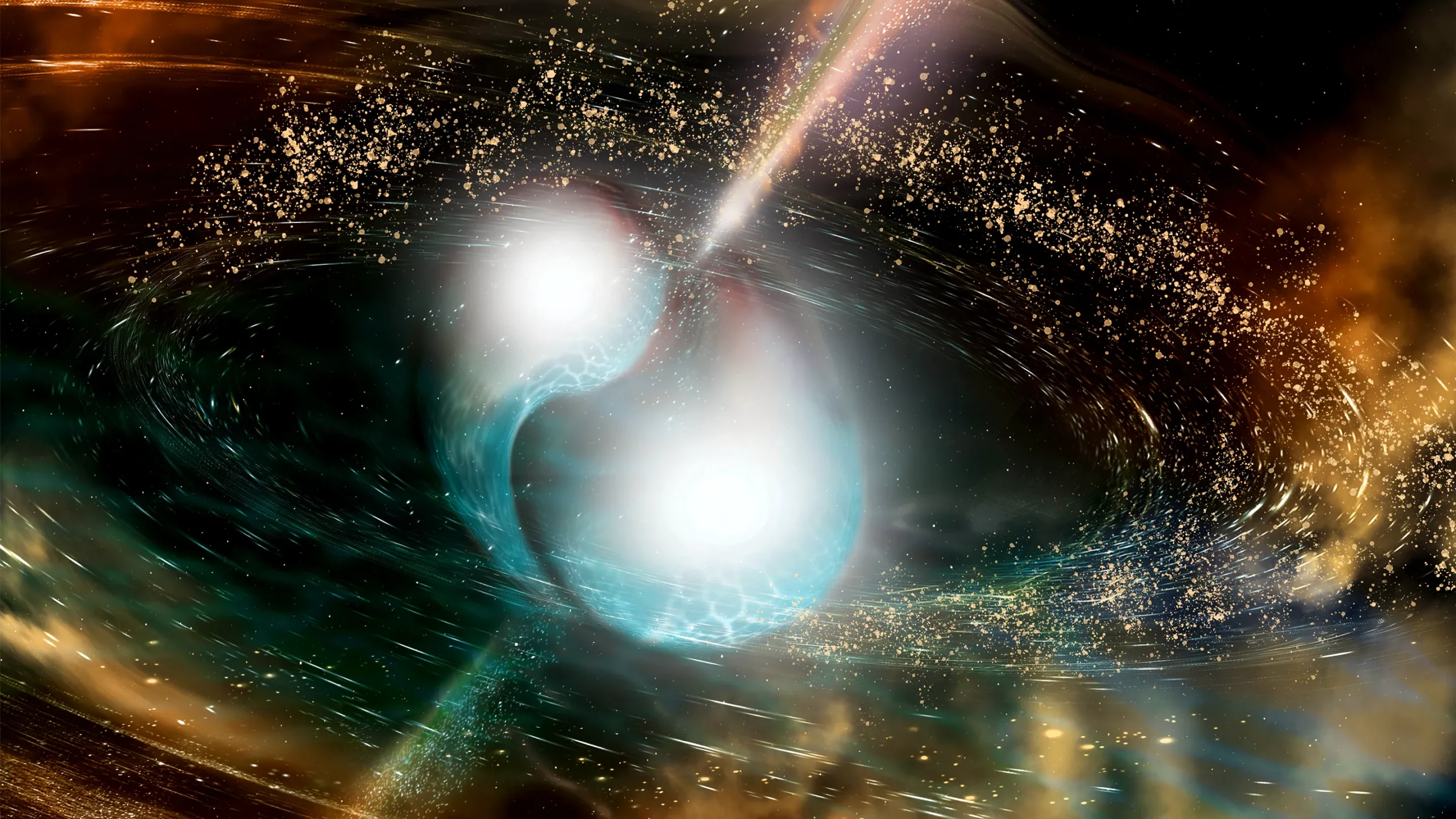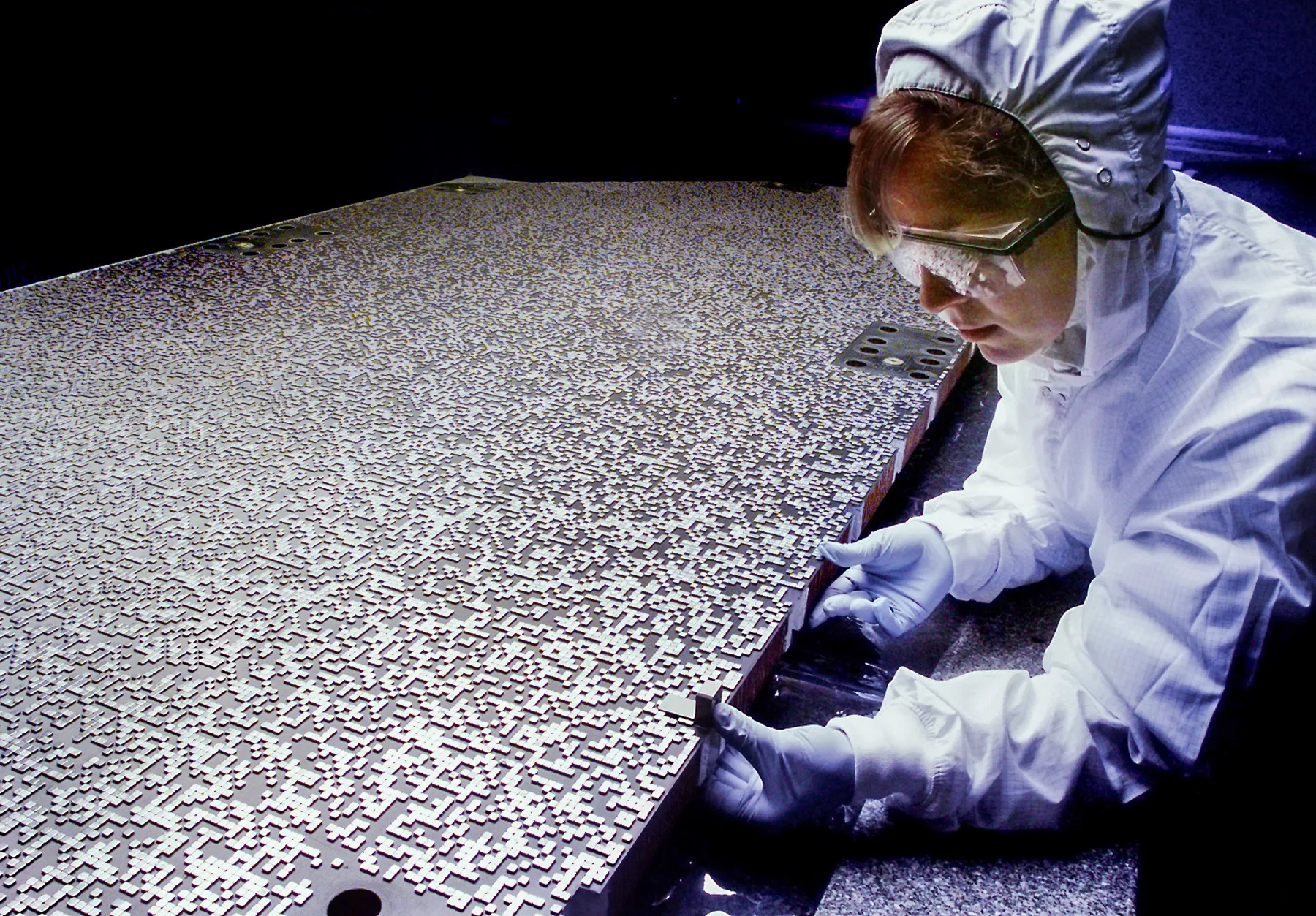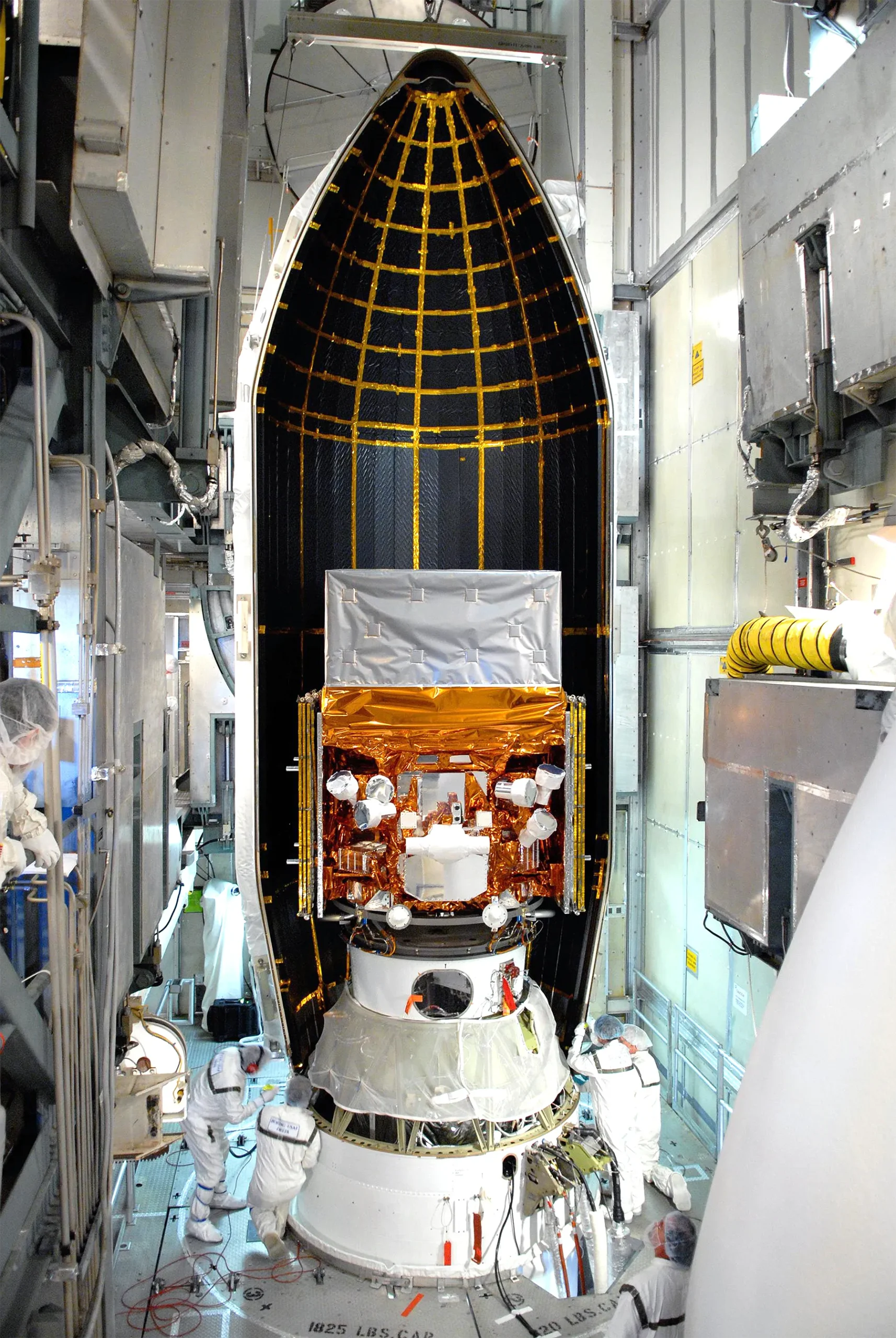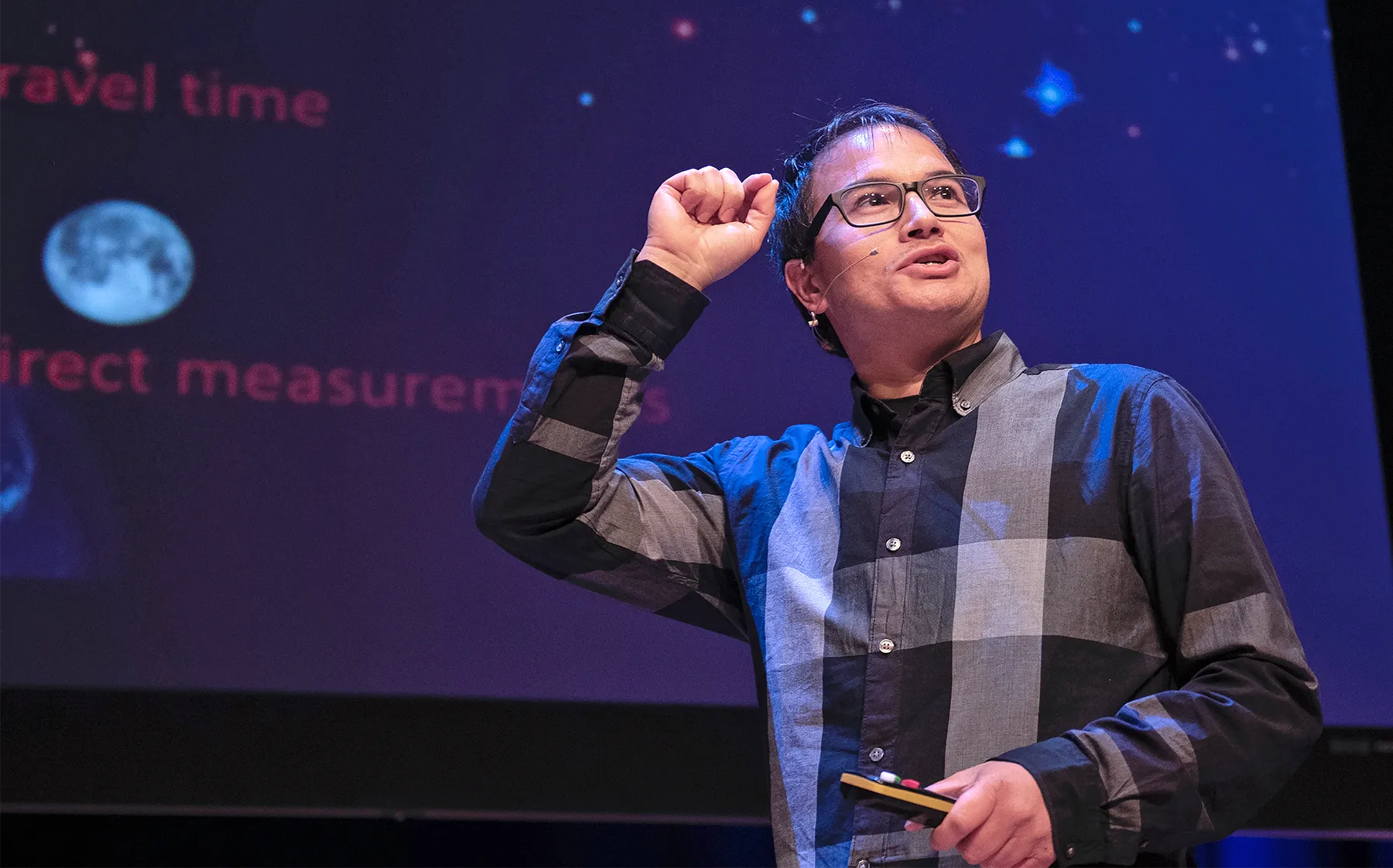Extra-Long Blasts Challenge Our Theories of Cosmic Cataclysms

When dead stars collide, they launch a blast of gamma rays into space — and in the glittering debris surrounding the smashup, elements such as gold and platinum are forged.
National Science Foundation/LIGO/Sonoma State University/A. Simonnet, edited by MIT News
Introduction
On December 11, 2021, a beam of gamma rays — the most energetic form of light — slammed into NASA’s Swift satellite. Within 120 seconds, the satellite had swiveled toward the blast and spotted the glowing embers of a cosmic catastrophe. Ten minutes later, alerts went out to astronomers around the world.
Among them was Jillian Rastinejad, a graduate student at Northwestern University. To Rastinejad and her collaborators, this gamma-ray burst looked oddly similar to an unusual burst from 2006. Rastinejad called up the Gemini Observatory in Hawai‘i and enlisted researchers there to stare deeply at the patch of sky where the burst had come from. A few days later, when clouds rolled in, a researcher at the MMT Observatory in Arizona took over, doing her best to keep the telescope trained on the fading spot of light a billion light-years away.
It was no small feat given that the weather was turning there too, Rastinejad said. “She found a hole in the clouds for us around 4 a.m. every day.”
By the time the chain of observations had wrapped up a week or so later, Rastinejad and her colleagues had a pretty good idea of what had fired those gamma rays across the universe. As they’d watched, the burst’s aftermath had turned redder and redder — an unmistakable sign that in the debris, heavy atoms like gold and platinum were being forged. The main source of such cosmic alchemy is collisions involving neutron stars, the unimaginably dense cores of dead suns.
The only problem was that such a conclusion seemed impossible. When neutron stars merge, astrophysicists suspect, it’s all over in a fraction of a second. But Swift had recorded a gamma-ray bombardment lasting a relatively interminable 51 seconds — normally the signature of a very different type of cosmic drama.
Since then, astronomers have identified more events like this. The most recent occurred in March, when the second-brightest gamma-ray burst ever detected lasted for 35 seconds. Again, astronomers observed the ruddy aftermath of a neutron star collision. They also recruited the James Webb Space Telescope to study the bizarre burst and spotted signs of the heavy element tellurium in the settling dust.

Along with her collaborators, Jillian Rastinejad, a graduate student at Northwestern University, solved the mystery of a perplexing gamma-ray burst that slammed into Earth in 2021.
Dennis Lee
Together, the string of observations brings a new mystery to an area of astronomy that most researchers had considered settled: What causes these supposedly quick, violent events to blast out gamma rays for so long? It’s a puzzle astrophysicists will have to solve if they want to achieve the more ambitious goal of understanding the origins of all the different elements in the universe, many of which are born from these violent outbursts.
“I’ve been really excited to see this,” said Daniel Kasen, an astrophysicist at the University of California, Berkeley who specializes in cosmic explosions. “It’s posed a real puzzle.”
Cold War, Brilliant Explosions
Today, Swift catches a gamma-ray burst every few days. But the blasts were unknown until the height of the Cold War, when they appeared out of nowhere. In the 1960s, the U.S. Air Force launched the Vela satellites to make sure the Soviet Union was abiding by a nuclear weapon test ban. If the Soviets detonated a nuclear bomb in space, the resulting flash of gamma rays — energetic waves of light as short as the nucleus of an atom — would be impossible to hide.
The satellites didn’t detect any Soviet violations. But between 1969 and 1972, they did pick up 16 mysterious flashes of gamma rays that researchers at Los Alamos National Laboratory determined to be of “cosmic origin.”
In the following decades, NASA took up the investigation. The space agency launched a dedicated burst-hunting satellite in 1991, and over the next nine years, it detected nearly 3,000 gamma-ray bursts. The events came in two varieties: short and long. Most short bursts lasted less than a second, while many long bursts went on for a minute or longer (the dividing line between the two flavors comes at around two seconds).
Whatever was causing these bursts seemed catastrophic; in less than half the duration of a pop song, they emitted about as much energy as our sun produces over billions of years. What could possibly blaze so brightly? Astrophysicists initially weren’t sure, but the tremendous energies involved pointed to world-ending cataclysms. And the two durations hinted at two types of catastrophes, a faster one lasting around a second and a (somewhat) slower one unfolding over a minute.
Astronomers found the origin of the slower bursts first. In the late 1990s, when researchers got better at pinpointing the direction a burst came from, they started to catch afterglows that hinted at cosmic explosions. Then, in 2003, astronomers watching a nearby afterglow saw the brilliant fireworks of a supernova just days after a long gamma-ray burst: The burst had signaled the first stage in the death of a giant star.
Understanding the faster cataclysm would take another decade and sharper tools. The breakthrough instrument proved to be NASA’s Swift satellite. Launched in 2004, Swift featured a meter-long patterned lead plate that could snare gamma rays from a wide swath of the sky. Crucially, it also possessed the unique ability to swiftly swivel a pair of onboard telescopes in the direction of any astronomical outbursts. (According to lore among Swift scientists, this point-and-shoot technology was partially developed for another Cold War defense project: Ronald Reagan’s Strategic Defense Initiative — informally known as “Star Wars” — which aimed to shoot down nuclear missiles mid-flight.)
With Swift, astronomers could now get eyes on a burst within two minutes — quickly enough to catch the afterglows of short gamma-ray bursts for the first time. While watching the initial flash fade, astronomers also saw signs of an ensuing explosion, one that grew redder over time. Astrophysicists soon calculated that this redness was to be expected after a merger involving a neutron star (which could be a smashup between two neutron stars or between a neutron star and a black hole). Such a collision would expel debris that blocked shorter, bluer wavelengths of light. Matching those explosions, dubbed kilonovas, with the brief gamma-ray flashes that preceded them provided strong circumstantial evidence that neutron star mergers were the short catastrophe.

Gamma rays are so energetic that they punch straight through standard optical materials. The Swift satellite stops gamma rays with this patterned lead plate and uses the “shadows” they cast on a sensor to estimate their location in the sky.
NASA
Direct evidence came on August 17, 2017. Two nearby neutron stars collided and shook the fabric of space-time, producing gravitational waves that the Laser Interferometer Gravitational-Wave Observatory (LIGO) could detect. By reading the information coded in those ripples, scientists would later calculate the masses of the colliding objects and learn that they were neutron stars. Just after the gravitational waves arrived, the Fermi Gamma-ray Space Telescope picked up a two-second-long gamma-ray burst. And in the following days, astronomers saw the telltale reddening of a kilonova in the same spot as the gamma-ray burst. The three back-to-back observations left little room for doubt: Short bursts could come from neutron star mergers.
“That cemented everything,” said Brian Metzger, an astrophysicist at Columbia University and one of the theorists who first predicted what the kilonova after a merger would look like. “[We thought] ‘OK, this picture really makes sense.’”
That picture is now starting to fracture.
A Third-Act Twist
First came Rastinejad’s 51-second burst in late 2021. It looked a lot like a lengthy nearby burst from 2006 that, puzzlingly, appeared to lack a supernova. But with modern instruments and a deeper understanding of what to look for, Rastinejad and colleagues were able to see what astronomers in 2006 had not: The 2021 burst was followed by a dim red kilonova.
That observation spurred Andrew Levan of Radboud University to revisit a mysterious 64-second burst he’d been puzzling over since 2019. The burst had gone off in the heart of an ancient galaxy where star births and deaths (in the form of supernovas) had ceased eons ago. In June, Levan and his collaborators argued that the most likely explanation for their long burst was that two stellar corpses — at least one of which was probably a neutron star — had found each other and merged.

NASA’s Fermi Gamma-ray Space Telescope, now in low Earth orbit, helps scientists study the cosmic events that produce gamma rays, the most energetic form of light in the cosmos.
NASA/Jim Grossmann
And now, the James Webb Space Telescope has supplied the clearest view yet of what comes after an anomalous burst. When the 35-second burst reached Earth on March 7, Swift’s gamma-ray-sensing lead plate was facing in a different direction. The energetic rays were detected mainly by Fermi, which pegged it as the second-brightest gamma-ray burst of all time (following a record-setting event in 2022).
In lieu of Swift, astronomers used an interplanetary fleet of spacecraft (including probes at Mars and Mercury) to pinpoint the burst’s position. In the days afterward, when telescopes on the ground again saw the signature reddening of a kilonova, Levan quickly fired off an emergency request for an almost real-time JWST observation of the event. “Luckily for us, they said yes,” Levan said. “That allowed us to get those observations about a month after the initial burst.”
JWST collected a bonanza of data from the billowing debris field. Optical telescopes can’t see deeply into the thick kilonova cloud for precisely the reason the event captivates astrophysicists: It spews out giant, light-blocking atoms through an arcane chain of events known as the r-process.
Stars typically fuse hydrogen atoms into helium and then later fuse lighter atoms into somewhat heavier atoms like oxygen and carbon. The r-process is one of the only ways to leap straight to the heaviest naturally occurring elements. That’s because a neutron star collision creates a dense maelstrom of neutrons. In the chaos, neutrons repeatedly worm their way into atomic cores, forming highly unstable and radioactive atoms. As neutrons in these atoms decay, they transmute into protons. If you end up with 78 protons, that’s an atom of platinum. If you get 79 protons, that’s gold.
The bulky atoms forged by a neutron star dust-up block visible light and shine mostly in infrared light. That’s why JWST — an infrared telescope — was so well suited to peering into a kilonova cloud. “We’ve never observed a kilonova with JWST before,” Metzger said. “It’s the perfect instrument.”
In the debris, JWST spotted tellurium atoms (52 protons), which confirms that neutron star mergers can forge the rather heavy elements toward the end of the fifth row of the periodic table. “It’s a much heavier element than ones we’ve seen before,” Levan said.
But at the same time, the JWST observation adds to the growing realization that, regardless of how unlikely it once seemed, mergers involving neutron stars can produce long gamma-ray bursts. The question now is: How?
Dense Objects, Long Bursts
Supernovas shoot out long gamma-ray bursts because stellar explosions are relatively slow and messy. A giant star’s death starts with its center collapsing into a black hole. After that happens, a substantial amount of the external star stuff — perhaps adding up to the mass of several suns — spirals into the black hole, launching powerful jets of particles that fire gamma rays into the void for up to several minutes.
Neutron star mergers, by contrast, are supposed to be over in a flash. A neutron star packs the mass of a sun or so into a smooth, tiny sphere just a few miles across. When two of those dense orbs collide — or when one smacks into a black hole — the matter collapses into a black hole. During that final spasm, far less leftover matter gets thrown into orbit than in the case of stellar collapse. As the black hole scarfs down this light snack, which might weigh 10 times less than the sun, it briefly powers jets (and a gamma-ray burst) lasting tenths of a second.

Andrew Levan and his colleagues want to figure out which cosmic events forge each naturally occurring element in the periodic table. To do that, they need to keep a detailed account of cataclysms such as neutron star mergers.
University of Warwick
The new observations from Levan, Rastinejad and others clash with this quick and clean image of neutron star mergers. “It doesn’t make any sense to have a 10-second burst from a system that lives only a fraction of a second,” said Ore Gottlieb, a computational astrophysicist at the Flatiron Institute who was not involved with the observations.
One possibility is that something larger and messier than neutron stars is sending out these enduring blasts. In particular, their longer duration would more naturally fit with a merger between a white dwarf — a larger kind of stellar corpse left behind when a small star runs out of fuel — and a black hole or neutron star. That scenario results in more matter surrounding a black hole. But it’s unclear if collisions involving white dwarfs would produce the right sorts of gamma-ray bursts, or even kilonovas. “The whole phenomenon has been much less studied,” said Kasen of Berkeley. “We’re working on it right now.”
Another option is that the long gamma-ray bursts don’t come from feasting newborn black holes at all. Instead, if you smash together two tiny neutron stars and the resulting blob spins fast enough, it might resist collapsing into a black hole for a few minutes. The short-lived object would be a highly magnetized neutron star — a “magnetar” — that would emit a longer gamma-ray burst as its twirling slowed. Metzger helped flesh out this scenario, but even he considers it a radical notion. “I’m still just sort of rightfully skeptical of it,” he said.
The most conservative possibility, Metzger said, is that mergers involving neutron stars are just messier than astrophysicists thought. Over the summer, detailed simulations from a collaboration led by Gottlieb suggested that this might often be the case. In particular, when a light neutron star meets up with a sufficiently heavy spinning black hole, the neutron star spirals in and the black hole shreds it over hundreds of orbits, leaving a heavier disk of material that the black hole needs tens of seconds to consume. While simulating collisions between neutron stars and black holes, Gottlieb, Metzger and collaborators found that heavier disks driving longer gamma-ray bursts were quite common.
In fact, in an ironic twist, their simulations didn’t produce the often-observed short bursts as readily as they did long bursts, raising questions about what exactly powers the short bursts.
“We don’t [fully] understand these things,” Gottlieb said. “I think this is probably the biggest problem now.”
Filling in the Gaps
To figure out what really goes down when dead stars collide, astronomers will need to redouble their efforts to build a detailed catalog of gamma-ray bursts, since what they assumed to be a batch of mainly supernova-driven explosions now appears to be mixed up with some unknown number of neutron star mergers. That will require hunting for kilonovas — the signature of collisions — after both long bursts and short ones. If the distinction between long and short persists, it could be a sign that there’s more than one way to cook up a kilonova.
“We’re learning that anytime there’s an event that’s relatively close by, we should go for it,” Rastinejad said.
LIGO will also play a critical role. The observatory was offline for upgrades during these recent oddball bursts, but it’s currently in the middle of its fourth run listening for the distant collisions. If LIGO can pick up gravitational waves coming from a long gamma-ray burst, scientists will know whether neutron stars or black holes were involved. This will also allow them to rule out white dwarfs, which don’t make gravitational waves detectable by LIGO. Detailed wiggles in waves at future observatories might even offer hints about whether the immediate product was a magnetar or a black hole.
“[Gravitational waves] will be really the only definitive way forward on this question,” Metzger said.
By sensing the gravitational rumbles of neutron star mergers and observing gamma-ray bursts and kilonovas, astrophysicists might eventually accomplish their long-term goal of fully accounting for the origin of every substance in the universe — from hydrogen to platinum to plutonium. To do that, they need to know what types of mergers happen, how frequent each type is, which elements each type produces and in what quantities, and what role other events like supernovas play. It’s a daunting undertaking that’s only just beginning.
“There’s still a core goal of working out the astrophysical sites where every single element in the periodic table is formed,” Levan said. “There are still blanks, and so we think this is starting to fill in several of those important blanks.”
Editor’s note: The Flatiron Institute is funded by the Simons Foundation, which also funds this editorially independent magazine. Neither the Flatiron Institute nor the Simons Foundation has any influence over our coverage. More information available here.





